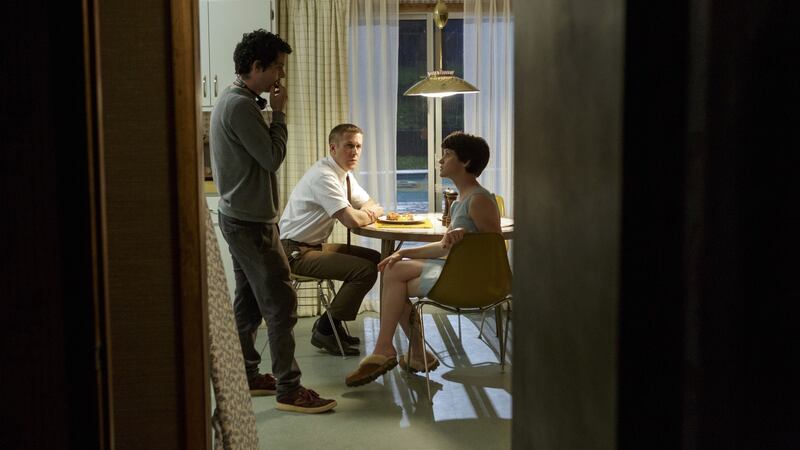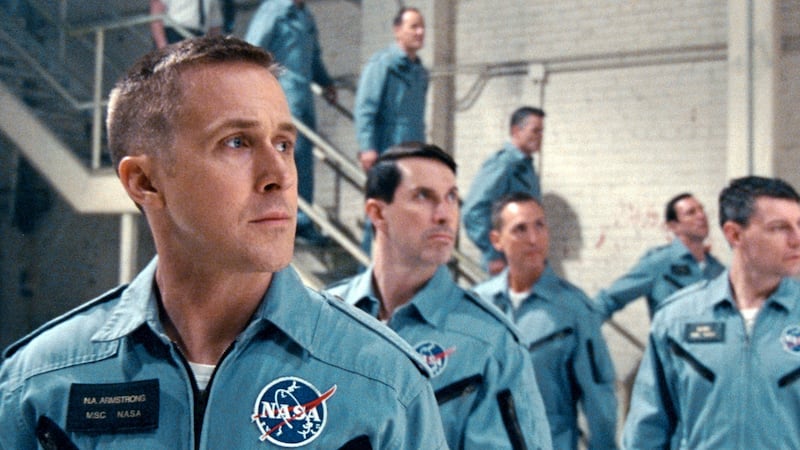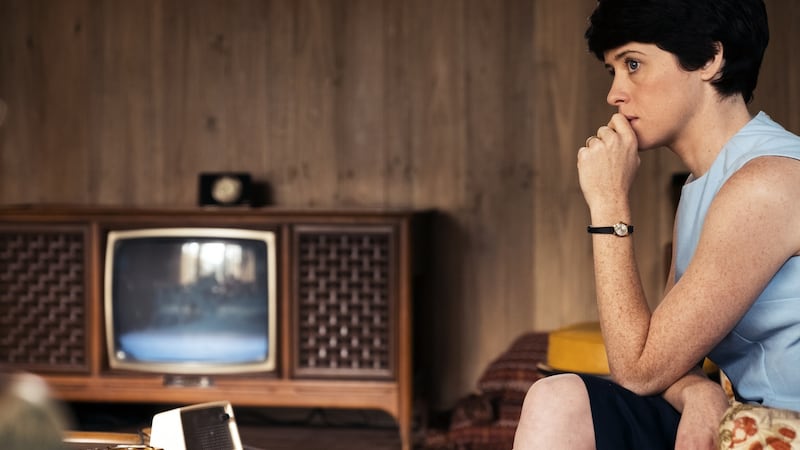When First Man premiered at the Venice Film Festival last month, nobody was expecting critics to use the term "un-American". An immaculate dramatisation of the years leading up to the lunar landing from La La Land and Whiplash director Damien Chazelle and Oscar-winning Spotlight co-writer Josh Singer, the film is an unabashed celebration of Nasa's most admired mission.
Despite excellent notices and the fact that First Man is both figuratively and literally festooned in stars and stripes, certain partisan folks have found a way to take offence.
Shortly after its Venice bow, once it was revealed that Chazelle's film doesn't feature a scene of Neil Armstrong (Ryan Gosling) and Buzz Aldrin (Corey Stoll) planting the American flag on the moon's surface, various social media platforms went into meltdown.
I view the film as deeply patriotic and very much a celebration of the kind of character it took to make the mission a reality. I wanted to pay tribute
The filmmaker has insisted that the omission was not politically motivated and that he wanted to focus on the “unfamous stuff”, in particular “Neil’s solitary moments on the moon”.
The lack of flag planting was, nonetheless, immediately decried by Republican senator Marco Rubio as "total lunacy". In a tweet, Rubio rubbished the film as "a disservice at a time when our people need reminders of what we can achieve when we work together. The American people paid for that mission, on rockets built by Americans, with American technology and carrying American astronauts. It wasn't a UN mission".
Other right-leaning commentators weighed in soon after with the hashtag #BoycottFirstMan and various dismissals of the film as a “parody of America-hating Hollywood” and a prime example of “how history is erased and rewritten in line with progressive anti-Americanism”.
"Omitting the seminal moment in the midst of mankind's greatest achievement seems a purposeful denigration of the 400,000 Americans who accomplished it," said actor and celebrity Republican James Woods.
Inevitably, United States president Donald Trump had his spoke, too: "It's unfortunate," he told the Daily Caller website. "It's almost like they're embarrassed at the achievement coming from America, I think it's a terrible thing. When you think of Neil Armstrong and when you think of the landing on the moon, you think about the American flag. For that reason, I wouldn't even want to watch the movie."

‘All mankind’
By way of response, Neil Armstrong's sons Rick and Mark Armstrong, along with author James Hansen, who wrote the book on which First Man is based, issued a joint statement in support of the film: "We do not feel this movie is anti-American in the slightest," they said. "Quite the opposite. But don't take our word for it. We'd encourage everyone to go see this remarkable film and see for themselves. This story is human and it is universal. Of course, it celebrates an American achievement. It also celebrates an achievement for all mankind."
In London, ahead of the film’s European release, Chazelle admits that he’s still surprised by the largely Twitter-stirred furore.
“I view the film as deeply patriotic and very much a celebration of the kind of character it took to make this a reality,” he says. “It’s an insane thing that these people did. I wanted to pay tribute to that, and I think anyone who sees the movie will see that’s the case.”
Had Trump et al bothered to see First Man, they'd note that the lack of flag-planting is entirely in keeping with the rest of Chazelle's genre-defying film. First Man entirely eschews the grandiosity of wide-angle Right Stuff shots and established visual grammar in favour of visceral extreme close-ups. Watching it, it's impossible not to think of David Bowie singing "sitting in my tin can" in Space Oddity. And to feel slightly nauseous.
There is a bracing sense of entombment with every claustrophobic mission depicted. There are near-misses and fatalities. Vessels hurtle and freefall with dials spinning. Even the purposefully rickety training equipment leaves an entire room of astronauts covered in their own vomit. The space age has seldom looked less sleek and shiny.
"I was struck the [craft] do look like tin cans or coffins," says Chazelle. "They're so obviously handmade, from a contemporary perspective. They almost look like things that belong more to the machine age – or even earlier – than they do to the space age. So we wanted that do be the driving force behind the visuals of the movie. Maybe it's because Challenger happened when I was about two. I don't remember it. But space had been tinged with that when I first started to become aware of space travel."

‘Real people’
Writing in Variety, critic Owen Gleiberman praised First Man as being "so immersive in its glitchy, hurtling, melting-metal authenticity that it makes a space drama like Apollo 13 look like a puppet show". In order to achieve the film's rigorous levels of realism, Chazelle and the production team worked closely with Nasa and the Armstrong family. Michael Collins, the command module pilot for Apollo 11, was a consultant, as was Buzz Aldrin, who followed Neil Armstrong on to the moon, and Alfred Worden, the command module pilot for the Apollo 15 lunar mission in 1971.
"Even before we were shooting Josh [Singer], the writer, spent time with [Buzz] to make sure that certain details were right," says Chazelle. "Both him and Mike Collins. And that was a huge honour. It was a little nerve-wrecking too, as you might expect. The actors are donning the suits. You're trying to recreate these indelible moments in history. And you have the real people on set, looking over your shoulder to make sure you get it right. That was daunting. But that was kind of how we felt the whole course of the movie. We felt we had a responsibility to try to get this right and be as authentic as possible. We wanted someone who was present at the time. So any time we would do a mission, we would try to make sure we had somebody there on set. Whether it was Buzz or Mike or Al Worden or a later Apollo astronaut or one of Neil's family."
That attention to detail was maintained by the actors. Ryan Gosling spent time at the Armstrong Air and Space Museum, Nasa's Cape Canaveral and Houston facilities, and with Neil's sister, June, at her farm in Wapakoneta, Ohio, where Neil was born.
Pat White, the widow of Ed White, an astronaut who was once billed as "the next John Glenn", took her own life in 1983. Actor Olivia Hamilton, who plays Pat in the film, sought out surviving family members.
"I went to Dallas to meet her daughter Bonnie White and I spoke on the phone with her son," says Hamilton. "They were really helpful at filling some of the blanks. You don't really read anything specific about Pat in any of the interviews you find. There was a risk of playing her like a generic astronaut's wife based on some if the books out there. Bonnie helped define her. This was who my mother was; this was her relationship. And that was what Jason Clarke [who plays Ed White] and I used to create the characters."
And they really are characters. One of the most admirable aspects of First Man is that it represents a giant leap for womankind in its depiction of the astronauts' wives.

‘Insane enterprise’
“In developing the story, Damien and Josh would talk a lot about wanting the women to be written in a way that was specific and holistic and showed nuance,” says Hamilton. “We were lucky in getting a script where that was already baked in.”
"Damien was always very clear that he wanted to make a film that analysed the quest to go to the moon through Neil's eyes and his family," says Claire Foy, who plays Neil's wife, Janet Armstrong. "It wasn't just one man that made this happen. He had children and a wife and in order to go to the moon he had to leave them behind. Josh Singer, in the script, and Damien never made it feel like Janet or any of the other characters were secondary to Neil. It was very much a story where everybody had a vested interest. I was very appreciative of that. It wasn't a cliché. It wasn't just a wife part. The fact that she was his wife was incredibly important to the story."
Foy, who is best known for playing Queen Elizabeth II in The Crown – another historical figure who has to keep up appearances in times of crisis – notes that despite the wealth of materials written about the Apollo missions, there is very little material available on Janet Armstrong.
“I never got to meet Janet, unfortunately,” says Foy. “But I was very lucky to be welcomed by the Armstrong family, by Rick and Mark, who gave me so much information and help with portraying their mother.”
“We have computers in our pockets that are more powerful than the ones that got us to the moon” became a mantra during the film’s pre-production period. Director Chazelle remains awestruck by the madness and impossibility of what Nasa and Armstrong achieved.
“This idea of how difficult it is to, say, break free of Earth’s atmosphere, how difficult it is to break free of Earth’s orbit as they did in the ’60s, and of course how difficult it is to go all the way to the moon,” says the Academy Award-winning director. “And the magnitude of distance that that represents. Now we have the benefit of living in the afterglow of the success story of the moon landing. For me, it was important to show how crazy the whole thing was. It was a potentially insane enterprise that just happened to work and it worked because of these incredibly brave, hardworking individuals.”
First Man opens October 12th













